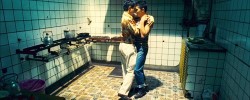Lai Yiu Fai and Ho Po Wing are like any other quarrelsome gay couple from Hong Kong. They have sex, and they fight. And when the petulant and precocious Ho has decided he’s had enough of slumming with the sincere, hardworking Lai, he leaves him. After all, he can always say, “Can we start over?” and he knows that Lai will take him back.
They live in a small, rundown apartment. They own a cylindrical lamp whose shade depicts an immense waterfall made to appear as though it is running by a rotating, perforated screen that causes the light to illuminate different spots on the screen in succession. Turns out, the lamp depicts a real waterfall in Iguazu, Argentina.
So they decide to go to Argentina and, among other things, check out the waterfall. But, as you can already imagine, things go wrong, and they end up stuck in the country without enough money to get home to Hong Kong.
Wong Kar Wai’s earlier work consisted primarily of narratively nonlinear art films that frequently included elements of criminality and violence. He made his name as a filmmaker with beautiful, oversaturated cinematography, sincere, lonely characters and lots of internal monologue. Then he started making love stories.
This film is more straightforward than Wong’s previous work. There is a cohesive plot, only three main characters and a mostly chronological progression from beginning to end. However, Wong has found a way, even within this conventional framework, to make a movie that confounds sense and expectations of intelligibility.
Wong weaves a tale with plenty of beautiful, ugly, intense and painful shots, but with precious little connecting one scene to the next. Like playing a childishly made flipbook, the viewer can usually piece together what’s going on. But Wong leaves out just enough crucial detail to keep one guessing.
For example, we imagine Ho is sleeping with other people for money as Lai diligently slaves away at one job after another in Buenos Aires. But what is the nature of the arrangement? Is it prostitution, or does Ho just have a lot of rich boyfriends? How many? Who beat him up, and what exactly does it have to do with a watch?
The camera follows Lai so diligently, it seems we know everything about him. Ho is the exciting and tragic mystery boy. But then what of Lai’s relationship with Chang, the Hong Kong native and dishwasher at the restaurant where he cooks for a time? What about this past of his that seems at odds with his present self?
To further the guesswork, Lai engages in far less of Wong’s trademark internal monologue that keeps the viewer on track while evoking empathy for the protagonists. We don’t even hear his internal voice until halfway through the film, but perhaps that’s when he regains his voice.
This movie is rife with vivid squalor. The very first scene has Ho checking out his nearly naked body in a full-length mirror whose reflective surface is pocked, covering his image in little black splotches, making him appear diseased or covered in unspeakable filth. Time and again, Wong films the insides of the same deteriorating rooms, plaster falling from walls, edges of countertops crumbling away, broken tiles.
Lai, sponging Ho’s back, asks him where all the little bites came from. Ho tells him the mattress has fleas. Lai says, “That’s what happens when it rains.” They spray it with flea killer.
But in the increasing familiarity of this filth and decay, there is a certain comfort. We—the viewers as well as Ho and Lai—feel safe in these dismal little spaces. There is a little, tiny television, a colorful tablecloth and, of course, the waterfall lamp. It’s the sort of prop that you can lose yourself in. Indeed, Wong often cuts to an aerial image of the actual falls, and it is truly an awesome, powerful site. It looks less like a place and more like an abstract backdrop, an emotion.
Some of these scenes occur so rapidly that to blink—or to momentarily reflect on the quicksand-like struggles of one’s own life—is to miss them. They depict moments of simple, profound joy. Why is Lai patching the concrete roof of a tall building? So the sun can shine on his back and Ho can rub his shoulders. So Wong can briefly shoot a blue sky, puffy with little cumulus clouds. So we can see children playing on the quay.
For some reason, the most powerful of these moments involves nothing more than a strong breeze blowing the curtain and the tablecloth in the dingy little apartment. It’s as if, after the suffocating closeness, the violence and pain, a clean breeze revives the empty apartment and, by extension, the viewer.
The most confounding thing about this movie, however, is that it isn’t about who it purports to be about. The narrative seems to be running full speed, four lanes in one direction, and then another character careens into it at a crazy angle and hijacks the whole thing. This is classic Wong Kar Wai, reminiscent of the existential collisions that defined his Chungking Express (1994) for example.
Just as our lives are rarely at peace with a single trajectory, so are his films.
Wong Kar Wai’s Happy Together (1997)
Friday, April 20, 7 and 9:30 p.m.
Saturday, April 21, 7 and 9:30 p.m.
Sunday, April 22, 3 p.m.
Free for PSU students;
$2 all other students and seniors; $3 general admission

